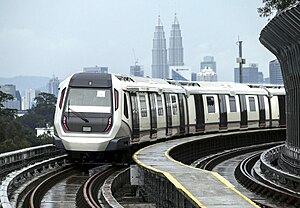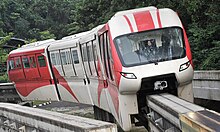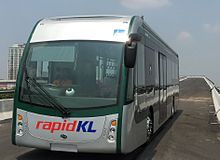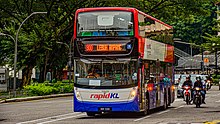Rapid KL
 | |
 Siemens Inspiro 4-car train on the Kajang Line. | |
| Overview | |
|---|---|
| Native name | Rangkaian Pengangkutan Integrasi Deras Kuala Lumpur |
| Owner | Prasarana |
| Locale | Klang Valley, Malaysia |
| Transit type |
|
| Number of lines | |
| Number of stations |
|
| Daily ridership |
|
| Website | myrapid |
| Operation | |
| Began operation | 16 December 1995 |
| Operator(s) | Rapid Rail Sdn Bhd Rapid Bus Sdn Bhd |
| Technical | |
| System length |
|
| Track gauge | 1,435 mm (4 ft 8+1⁄2 in) standard gauge |
Rapid KL (styled as rapidKL) is a public transportation system owned by Prasarana Malaysia and operated by its subsidiaries Rapid Rail and Rapid Bus. With its coverage throughout Kuala Lumpur and Klang Valley areas, it was followed by a federal government restructuring of public transport systems in Kuala Lumpur after the bankruptcy of STAR and PUTRA Light Rapid Transit operators, the precursors to the Ampang/Sri Petaling Lines and Kelana Jaya Line respectively.[1] In 2003, it had inherited bus services and assets formerly operated and owned by Intrakota and Cityliner after being bailed out. Four years later, the Malaysian government had bailed out KL Infrastructure Group, the owner and operation concession holder for the Kuala Lumpur monorail, and had placed it under ownership of Prasarana.
Rapid KL is part of the Klang Valley Integrated Transit System. The acronym stands for Rangkaian Pengangkutan Integrasi Deras Kuala Lumpur (English: Kuala Lumpur Rapid Integrated Transport Network).
History[]
Public transport restructuring[]
The operation of Kuala Lumpur's Light Rapid Transit lines since its inception had lower ridership that expected, which led to the concessionaire operators of the LRT lines, Sistem Transit Aliran Ringan Sdn Bhd (STAR-LRT) and Projek Usahasama Transit Ringan Automatik Sdn Bhd (PUTRA-LRT) being unable to repay their commercial loans. The 1997 Asian financial crisis aggravated the situation, and by November 2001, the two companies owed a combined total of RM5.7 billion. The Government of Malaysia's Corporate Debt Restructuring Committee (CDRC) stepped in to restructure the debts of the two LRT companies. In 2002, both companies and their respective LRT services were bought over by Prasarana Malaysia, and operations of the lines eventually were transferred to Rapid KL.
The Malaysian government would continue to bail out KL Infrastructure Group, which was the operator concessionaire holder and owner of the line, for RM 822 million. It was then promptly taken over by Prasarana Malaysia and operated by Rapid Rail since.[2]
The bus service in Kuala Lumpur was also facing problems with lower ridership due to an increase in private car usage and a lack of capital investments. The two new bus consortia formed in the mid 1990s to consolidate all bus services in Kuala Lumpur, Intrakota Komposit and Cityliner, began facing financial problems. Intrakota had reportedly accumulated losses amounting to RM450 million from the 1997 financial crisis until Prasarana Malaysia took over in 2003. With decreased revenues, the bus operators could not maintain their fleets, much less invest in more buses. Frequencies and service deteriorated as buses began breaking down, and ridership suffered as a result. Public transport usage in the Klang Valley area dropped to about 16% of all total trips as a result.
Improvement steps[]







Since taking over the LRT, monorail and bus network, Prasarana has taken steps to improve services.
- Price reduction: Most users of the LRT and monorail are students and elderly people. Students tend to choose the cheaper options and with a fare price increase in 2015 that doubled the original price, it was no wonder students chose other means of transportation than the Rapid KL.
- Increased rail capacity: Prasarana issued tenders for the purchase of new LRT and monorail rolling stock to increase carrying capacity, including 35 new train sets for the Kelana Jaya Line in October 2006 and October 2007. The trains were expected to be operational by September 2009. On 27 July 2009, Malaysian Prime Minister Najib Razak announced that the 35 new four-car trains would be operational by end-2012.[3]
- Expanded bus fleet: As most of the Rapid KL buses inherited were old and poorly maintained, the immediate concern was to get more buses on the road. In 2005, the government promised 200 new Rapid KL buses.
- Increased bus routes: Prasarana introduced several new routes to cover previously unserved areas.
- Scheduled bus services: Rapid Bus introduced scheduled services for 16 Rapid KL bus routes which were not heavily utilised. For the first time in Malaysia, expected bus arrival times and timetables were posted at bus stops along routes. However, the bus stop timetables as well as the myrapid website has since been removed due to the inability of services to reliably adhere to these schedules. This was primarily caused by problems such as traffic congestion and an insufficient number of serviceable buses.
- Common monthly passes for both the rail and bus networks: For the first time commuters were offered monthly passes which could be used on both rail and bus networks, helping to enhance the integration of the public transport system.
- Common signage for all Prasarana owned rail lines: The renaming of the PUTRA LRT and STAR LRT, lines along with the changing of the signage in the LRT and monorail stations helped to enhance the integration of the previously unconnected systems.
- Common Ticketing Systems: All rail lines under Rapid KL which previously functioned as separate systems were integrated with a new and single common ticketing system since 2011, allowing seamless transfer between the various rail lines. The stored-value Touch 'n Go could be used on all Rapid KL buses and rail lines as well.
- Revamp of the bus network: Prasarana scrapped the old Intrakota and Cityliner routes it inherited and introduced three types of bus services: City shuttles (BANDAR), trunk buses (UTAMA), local shuttles (TEMPATAN) and express buses (EKSPRES). City shuttles operate within Kuala Lumpur's central business district while trunk buses link hubs at the edge of the CBD with suburban transportation hubs. At these suburban hubs, local shuttles radiate out from rail-based public transport stations and fan out to residential areas. Express buses provide non-stop point-to-point travel to specific destinations.
Rail network map[]
Services under Rapid KL[]
Rail[]
The entire rail network, operated by Rapid Rail is 156.7 km long and has 116 stations. The network's trains can travel up to 80 km/h. In 2008, the rail network carried a total of over 350,000 passengers daily.[4] The BRT Sunway Line, despite being operated by Rapid Bus, is a component of and integrated with the Rapid KL network.
Current services[]
| Code | Line | Stations | Length | Began operation | Termini | ||
|---|---|---|---|---|---|---|---|
3 |
Ampang Line | 18 |
18 km |
16 Dec 1996 | Sentul Timur | Ampang | |
4 |
Sri Petaling Line | 29 |
45.1 km |
11 Jul 1998 | Sentul Timur | Putra Heights | |
5 |
Kelana Jaya Line | 37[5] |
46.4 km[5] |
1 Sep 1998 | Gombak | Putra Heights | |
| KL Monorail | 11[6] |
8.6 km[6] |
31 Aug 2003 | KL Sentral Monorail | Titiwangsa | ||
9 |
Kajang Line | 31[7] |
51 km[7] |
16 Dec 2016 | Sungai Buloh | Kajang | |
| BRT Sunway Line | 7 |
5.6 km |
2 Jun 2015 | Sunway-Setia Jaya | USJ 7 | ||
| TOTAL | 115 [Note 1] |
156.7 km |
|||||
Future services[]
| Code | Line | Stations | Length | Status | Planned opening |
Termini | |
|---|---|---|---|---|---|---|---|
11 |
Shah Alam Line | 25 | 37 km | Under construction | February 2024 | Bandar Utama | Johan Setia |
12 |
Putrajaya Line | 12 | 52.2 km | Phase 1: March 2022 | Kwasa Damansara | Kampung Batu | |
| 25 | Phase 2: January 2023 | Kampung Batu | Putrajaya Sentral | ||||
| Circle Line | 31 | 51.31 km | Pre-construction phase[8] | 2027 for Phase 1 | Bukit Kiara | PPUM | |
Bus[]
The entire bus network is operated by Rapid Bus, one of the largest bus operators in the Klang Valley area, along with Transnasional. Currently, there are 98 stage bus routes and 39 feeder bus services which operate from the rail stations. The bus routes operated by Rapid Bus were previously operated by Intrakota Komposit Sdn Bhd, a subsidiary of DRB-Hicom; and Cityliner Sdn Bhd, a subsidiary of Park May Bhd. In 2008, Rapid Bus carried around 390,000 passengers daily.[4]
On 18 June 2020, Rapid Bus released new features on real time locations of bus in Google Maps, via collaboration with Google Transit.[9][10][11][12] Almost 170 RapidKL bus routes are covered with this real time feature. Rapid Bus also plans to expand the application to MRT feeder bus service, Rapid Penang, and Rapid Kuantan in the future.
Fares and ticketing[]
Rapid Rail implements an automatic fare collection system with stored value tickets and single journey tickets in the form of tokens. Tickets can be purchased either from ticket vending machines or at station counters found at all train statioms stations.[13] Turnstiles are located at the entrances to train platform, which separate the paid area and unpaid area of the stations. In 2011, Prasarana Malaysia announced a new ticketing system, effectively integrating the different rail lines which previously functioned as different systems. The new system allowed passengers to transfer seamlessly between rail lines at designated interchange stations without exiting the system and paying multiple fares or buying new tokens.[14]
Touch 'n Go stored value cards are also accepted at fare gates on the Rapid Rail network as well as the Rapid Bus network as well as the KTM Komuter system to improve integration.[15] The Touch 'n Go system is also used in the production of Rapid KL's monthly/weekly passes as well as their stored-value concession cards.[16][17] These passes can be purchased by frequent users of the Rapid KL rail and bus networks, The Rapid KL concession cards are provided for students, the elderly and disabled people, which provides a 50% discount on all train and bus fares.[16]
Services[]
The rail services operate daily from 6 a.m. to 10p.m. The operation hours will be extended for certain stations when special events such as the final of Piala Malaysia[18] and New Year's Eve countdown[19] were held.
| Rail Lines | Peak-Hour Headway[20] |
|---|---|
| Ampang Line | 6 minutes |
| Sri Petaling Line | 6 minutes |
| Kelana Jaya Line | 3 minutes |
| KL Monorail | 8 minutes |
| Kajang Line | 4 minutes |
| BRT Sunway Line | 5 minutes |
During the Movement Control Order, the waiting times between trains were extended to 10 minutes during peak hours and 30 minutes during other times, as less people went outside due to the lockdown.[21]
On 10 September, RapidKL reduced its waiting times for trains and buses to support the growing number of workers going back to their reopened workplaces. On peak hours, trains arrived at around 4 to 10 minutes, on non-peak hours, trains arrived from 7 to 12 minutes, and on weekends they arrived on 7 minutes (central business district for LRT Ampang/Sri Petaling) or 15 minutes.[22][23]
Infrastructure[]
The Ampang Line consists of two sub-lines, one a north–south line and one heading eastward.[24] The Chan Sow Lin-Sri Petaling route serves the southern part of Kuala Lumpur. The Chan Sow Lin-Ampang route primarily serves the suburb of Ampang in Selangor and the town of Pudu in Kuala Lumpur, both of which are located in the northeastern region of the Klang Valley. Both lines converge at Chan Sow Lin; the merged line leads north, terminating at Sentul Timur LRT station.
The Kelana Jaya Line consists of a single line that connects Petaling Jaya in the west to Gombak in the northeast, passing through the city centre and various low density residential areas further north in Kuala Lumpur. The line has a total of 870 individual bridges, the longest of which has a 68m span.[25]
The Ampang Line and the Kelana Jaya Line intersect at Masjid Jamek and Putra Heights.
Stations[]
Since the Kelana Jaya and Ampang lines were intended to be operated by different owners during the planning and construction phase, both lines have unique and distinct station designs. Except for five underground stops between Pasar Seni and Ampang Park on the Kelana Jaya Line, the entirety of the LRT is elevated or at-grade. The Ampang Line consists of elevated and at-grade stations, while the Kelana Jaya Line comprises underground and elevated stations, in addition to one at-grade station. All trains are air-conditioned.
The Kelana Jaya Line runs in a northeast-southwesterly direction, consisting primarily of elevated stops and a handful of underground and at-grade stations. Of a total of 37 stations, 31 are elevated, and 5 stops are underground. The only at-grade station, Sri Rampai. The service depot is located in Subang.
The stations, like those of the Ampang Line, are styled in several types of architectural designs. Elevated stations, in most parts, were constructed in four major styles with distinctive roof designs for specific portions of the line. The KL Sentral station, added later, features a design more consistent with the Stesen Sentral station building. Underground stations, however, tend to feature unique concourse layout and vestibules, and feature floor-to-ceiling platform screen doors to prevent platform-to-track intrusions. 22 stations (including two terminal stations and the five subway stations) use a single island platform, while 15 others use two side platforms. Stations with island platforms allow easy interchange between north-bound and south-bound trains without requiring one to walk down/up to the concourse level.
On the Ampang Line, the system includes a total of 36 stations: eleven along the Chan Sow Lin-Sentul Timur line, seven along the Ampang LRT station-Chan Sow Lin line and eighteen along the Sri Petaling-Chan Sow Lin line. The service depot and primary train depots for the system are situated before the Ampang terminal station and the end of the Ampang-bound line, and beside the Putra Heights terminal at the end of Putra Heights-bound line. A secondary train depot is located after the Sri Petaling station.
The line between the Plaza Rakyat station to the Sentul Timur station is strictly elevated, with the line between the Bandaraya station to the Titiwangsa station running along the Gombak River. The Chan Sow Lin-Ampang line is primarily surface leveled, while the Chan Sow Lin-Plaza Rakyat line and the Sri Petaling-Chan Sow Lin line use a combination of surface leveled and elevated tracks. There are no subway lines in the system.
Notes[]
- ^ Counting interchange stations only once: Sentul Timur, Sentul Titiwangsa, PWTC, Sultan Ismail, Bandaraya, Masjid Jamek, Plaza Rakyat, Hang Tuah, Pudu, Maluri, Chan Sow Lin, Putra Heights, USJ 7 and Pasar Seni. KL Sentral (Kelana Jaya Line and KL Monorail) & Bukit Bintang (KL Monorail and Kajang Line) are not actual interchange stations despite the similar name. There is paid-to-paid integration between Merdeka (Kajang Line) and Plaza Rakyat (Ampang Line/Sri Petaling Line) stations, but they are operationally and structurally separate stations.
References[]
- ^ "Four public transportation projects under Dr M went bankrupt". The Star.
- ^ "Kuala Lumpur Monorail".
- ^ Nik Anis & Dharmender Singh (28 July 2009). "Targets set for the six Key Result Areas". The Star. Archived from the original on 31 July 2009.
- ^ a b "Penumpang Rapid KL naik mendadak". Utusan Malaysia. 9 July 2008. Retrieved 9 July 2008.
- ^ a b "Kelana Jaya Line". Prasarana Malaysia. Archived from the original on 30 March 2014. Retrieved 12 June 2014.
- ^ a b "KL Monorail Line". Prasarana Malaysia. Archived from the original on 30 March 2014. Retrieved 12 June 2014.
- ^ a b Sim Leoi Leoi (11 December 2016). "MRT first phase opens on Friday". The Star.
- ^ "MRT Line 3: Circle Line - Environmental Impact Assessment & Strategic Impact Assessment Letter to KL Mayor". Retrieved 6 August 2021.
{{cite web}}: CS1 maint: url-status (link) - ^ "Aplikasi Google Maps Untuk Bantu Rancang Perjalanan Dengan Bas". Retrieved 21 June 2020.
- ^ "Google Maps app to help Rapid bus users plan trips". Retrieved 21 June 2020.
- ^ "Rapid Bus collaborates with Google Maps app to help users plan trips, view real-time location of buses". Retrieved 21 June 2020.
- ^ "https://themalaysianreserve.com/2020/06/19/rapidkl-users-can-now-plan-bus-trips-via-google-maps/". Retrieved 21 June 2020.
{{cite web}}: External link in|title= - ^ "Rail Transportation in Kuala Lumpur". Japan Railway & Transport Review. Retrieved 16 August 2010.
- ^ Abas, Marhalim (15 June 2011). "One ticket for LRT and Monorail in November". The Malay Mail. Archived from the original on 23 July 2011. Retrieved 15 June 2011.
- ^ "What's Touch 'n Go - Where to Use". Touch 'n Go. Archived from the original on 10 February 2011. Retrieved 16 August 2010.
- ^ a b "Concession Cards - All Tickets | MyRapid Your Public Transport Portal". www.myrapid.com.my. Retrieved 15 May 2020.
- ^ "Go Cashless - All Tickets | MyRapid Your Public Transport Portal". www.myrapid.com.my. Retrieved 15 May 2020.
- ^ "Rapid KL Lanjut Perkhidmatan LRT di Stesen Bukit Jalil Sempena Perlawanan Akhir Piala Malaysia 2019 - Media Releases | MyRapid Your Public Transport Portal". www.myrapid.com.my. Retrieved 25 June 2020.
- ^ "Rapid KL lanjut perkhidmatan di stesen dan laluan terpilih - Media Releases | MyRapid Your Public Transport Portal". www.myrapid.com.my. Retrieved 25 June 2020.
- ^ "How to Travel with Us? - Traveling with Us | MyRapid Your Public Transport Portal". www.myrapid.com.my. Retrieved 25 June 2020.
- ^ "Kelana Jaya LRT line resumes operation | New Straits Times".
- ^ "Phase 2: Rapid KL expects increase in LRT passengers from Monday [NSTTV] | New Straits Times". 10 September 2021.
- ^ "Rapid Kl Revises Train and Bus Frequencies for Phase 2".
- ^ "Integrated Urban Transportation System - Riding the Rails". kiat.net. Archived from the original on 26 August 2010. Retrieved 2010-08-21.
- ^ "Kuala Lumpur LRT 2 Kelana Jaya Line: PUTRA". Halcrow. Archived from the original on 26 November 2010. Retrieved 21 August 2010.
External links[]
- Bus transport in Malaysia
- Malaysian brands
- Transport in Kuala Lumpur
- Transport in the Klang Valley
- 1995 establishments in Malaysia
